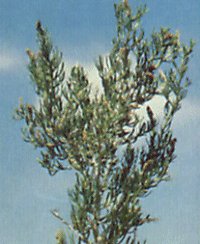GREASEWOOD


Description
Greasewood has many thorns and thick, narrow, green leaves on ridged branches. Its bark is smooth and white. Buds remain on plants most of the year. It grows 2 to 5 feet tall. Flowers are small and light green to whitish. The perennial belongs to the goosefoot family.

Greasewood is a range shrub that livestock can eat safely in moderate amounts with other forage. But when it provides most or all of an animal's feed, greasewood causes poisoning.
Losses may be high in the fall, when sheep eat large quantities of leaves that have fallen to the ground.
The toxic substances, sodium and potassium oxalates, are found in leaves and other aboveground parts of the plant. Greasewood increases in toxicity as the growing season advances.

Where and When It Grows
The shrub is adapted to the heavy saline and saline-alkaline soils of semiarid regions. It is found on the flood plains, along dry washes and gullies, and in other areas with moist soil.
The plant starts its growth in early spring. The leaves remain succulent until fall, when they freeze, dry, and drop off.

How It Affects Livestock
Acute poisoning causes death from heart failure, while a more chronic form causes kidney disturbances. Signs develope 4 to 6 hoirs after an animal eats a toxic amount of greasewood.
A sheep may die if it eats as much as 2 pounds of green leaves and fine stems in a short period without other forage. Cattle may die after eating 3 to 3 1/2 pounds of greasewood in a short period.

Signs of Poisoning
Early signs:
1. Dullness
2. Loss of appetite
3. Lowering of the head
4. Reluctance to follow the herd
5. Irregular gait
Advanced signs:
1. Drooling and a white froth about the mouth
2. Nasal discharge
3. Progressive weakening
4. Rapid and shallow breathing
5. Coma

BACK TO INDEX
H O M E
Would You Consider Signing
My Book?










